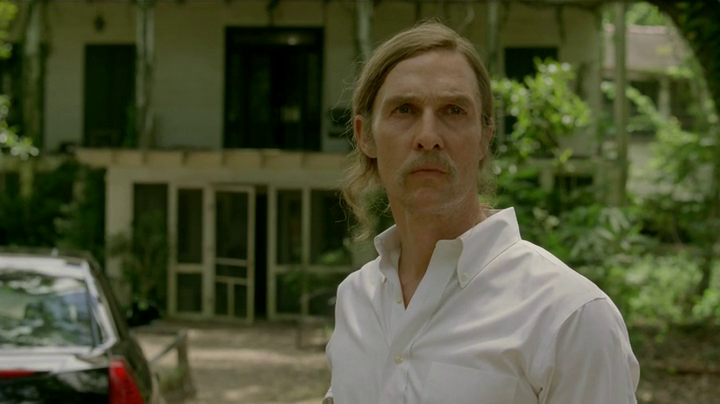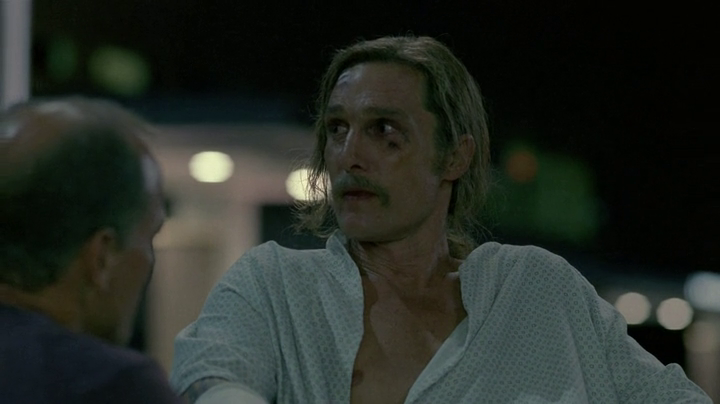True Detective Episode 8 Review: Form and Void

"A dream that you had inside a locked room. A dream about being a person. And like a lot of dreams there's a monster at the end of it."
These words back in the third episode from detective Rust Cohle neatly summarise the stunning first series of True Detective, and the heady crescendo it reached in the season finale, Form and Void. For eight episodes we've followed Matthew McConaughey and Woody Harrelson's characters in this southern gothic odyssey through the murky swamps of Louisiana, a malarial dream full of darkness and degradation.
Standard Serial Killer
With all the hints of state-wide corruption and unreliable narrators, you might have expected a more show-stopping finale with a sting in the tale. But what was most surprising about the episode was just how simple and straightforward it all was. Writer Nic Pizzolatto might have filled out his canvas with ambitious ideas about savagery in the south, the treatment of women and the hypocrisy of religious institutions; but in the end he was mainly focused on the battle between good and evil, and how two men of different mind-sets can develop a bond over the years
It means that despite all the build-up about Tuttle's schools initiative being related to disappearing children across the state, the big baddie of the season, the Yellow King, is just one psychotic caretaker, played with chilling menace by the aptly named Glenn Fleshler. The episode starts at his ramshackle bayou abode, a serial killer's lair with hallmarks to The Texas Chainsaw Massacre and Silence of the Lambs.
North by North West
Watching Hitchcock's classic North by Northwest, there's something undeniably creepy in watching our psycho switch between his natural southern drawl, and the clipped British accents of Cary Grant and James Mason that he impersonates.

The fact that he has sex with his mentally challenged half-sister, and has the corpse of his dad tied up in a shed, are even more repulsive. But perhaps most unnerving is when director Cary Juji Fukunaga employs POV shots from Childress as he looks on at children playing in a field whilst he paints the walls nearby.
It's his paintwork that leaves a trail of sorts for our two detectives, as Hart has a rather contrived epiphany that the "spaghetti monster with green ears" that one child spotted in 1995, actually was green due to a local paint job Childress was involved in. They make their way out to his house, where Rust says he knows it is the right place.
Carcosa
This is all build-up for what is the most breathtaking part of the episode, the near wordless pursuit of Childress by Rust through the labyrinthine old Spanish colonial fort that is Carcosa. It's another summation of the cinematic confidence of the show as we have a six minute sequence of horror-movie tension created by a torturous febrile atmosphere.
Well, once there was only dark. You ask me, the light's winning.
The only dialogue comes from Childress, as his echoing devil's voice lures Rust in to his Satan's pit, saying, "Come die with me, little priest". Rust reaches the bottom, where above him lies a 'flat circle', before a terrifying vision of a vortex appears. It's a stunning moment, one where, like Rust, I was so swept up in the nightmarish atmosphere that had been created that when childress comes rushing out and stabs Rust, it took me completely off guard.
Rust had pointedly mentioned earlier in the episode that the visions, "never stop, not really," and it would have been no surprise if Childress, the Yellow King, and Carcosa had all stemmed from his demented mind.
But in the end we were served a straightforward action finale as Childress was shot, Rust was stabbed and Marty got an axe to the chest. The fact both survive, and that the loose threads involving Tuttle and what Rust has been up to all these years remain a mystery, is both frustrating and slightly disappointing in its ordinariness. It's an ending which is both ambiguous and formulaic at the same time.
Light versus Dark
But in boiling it down to its most basic elements, this finale showcased the bromance between Hart and Cohle that lies at the real centre of True Detective. At the very end it's not Hart with his family, or Rust by himself, but the two of them talking outside Lafayette hospital, a bond that even the darkness around them can't break.
Hart's breakdown in front of his family might have felt hastily sketched, but it is enigmatic antihero Rust Cohle who gets closure. His speech to Hart at the end, of being wrong about the finality of death and the warmth he felt of his dead daughter in the darkness when lying in a coma, is a beautifully delivered scene. And their final exchange is so good that it bears repeating here:

Rust: "It's just one story. The oldest."
Marty: "What's that?"
Rust: "Light versus dark."
Marty: "Well, I know we ain't in Alaska, but it appears to me that the dark has a lot more territory."
Rust: "Well, once there was only dark. You ask me, the light's winning."
Whilst I've immensely enjoyed True Detective, it's fair to say it never quite reached the dizzying heights its early episodes suggested. It's a show that never felt more than the sum of its parts, spellbinding though some of those parts were. The writing, direction and two lead performances contributed to what will be one of the most memorable shows of 2014, and whoever steps in for McConaughey and Harrelson for season two has some very big shoes to fill indeed.
© Copyright IBTimes 2025. All rights reserved.






















